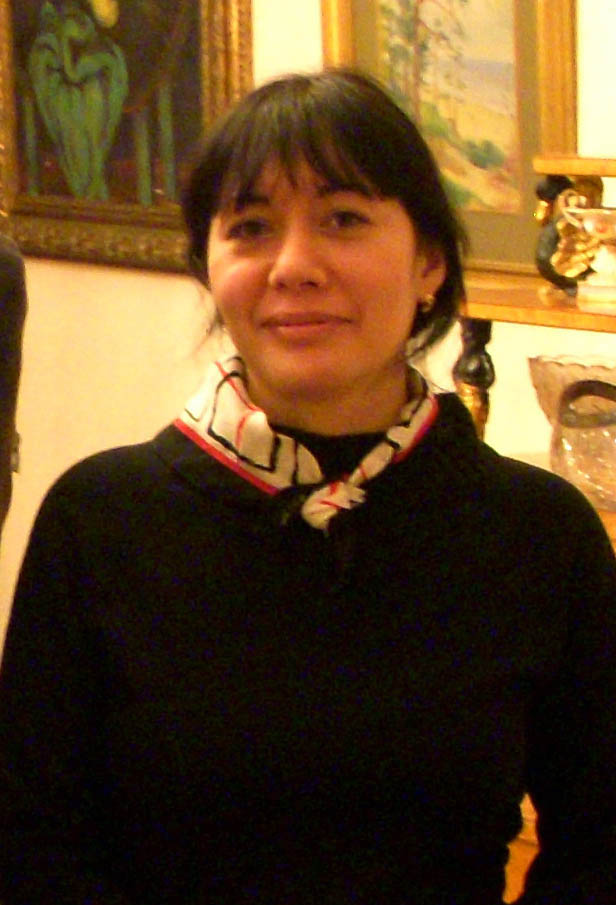Nadezhda Musyankova - Ph.D. in art history, senior researcher at the State Tretyakov Gallery.
A private collection always reflects the owner's choice, their personal tastes, disposition, aesthetic preferences and material well-being. Not everyone can afford to own a collection of paintings, since that requires more than just financial means, but also a subtle instinct, purposefulness and willingness to take risks, since works of art acquire their true value only over time.
The collector has a unique opportunity to discover the names of new artists for the public, to find unknown masterpieces of venerable authors, to dispose of their fate, and to observe its sinuosities. So many famous masters have gained recognition owing to the lively participation of admirers of their talent! Thus, the collections of art patrons Sergei Shchukin and Ivan Morozov became the basis of the impressionist collections of the Hermitage in St. Petersburg and the Pushkin Museum of Fine Arts in Moscow, and the merchant Pavel Tretyakov considered the creation of a museum of Russian art for the people the goal of his life.
These examples show how distinctly different art collections can be — someone buys what they like for themselves; another invests money, and someone wants to etch their name in the annals of cultural history.
Lyuba Matusovsky keeps only selected works of her favorite artists - Moses Feigin (1904-2008) and Irina Vilkovir (1913-1985). Let us try to understand what is the secret of this limited choice and what makes the paintings themselves so attractive?
Both artists were not famous from the official point of view - they did not have titles and government awards, and their lives happened to take place in the difficult Soviet times, when nationality line in your passport was of great importance. However, having an excellent command of the realistic method of painting, they proved their professional competence by joining the Moscow Union of Artists and completing state orders for political portraits and genre paintings. But at the same time, they continued to work for themselves, which was called "into the desk" meaning for later, since they could not show their creativity that was free from inhibitions to the public. Carrying out the official work, both Moses Feigin and Irina Vilkovir followed the unshakable canons of socialist realism, allowing themselves just a little more freedom than allowed in choosing the color scheme. They were much bolder within the privacy of their workshops, pouring out their inner passion in the expression of forms and brightness of unexpected color combinations. Both authors, each in their own way, searched for the inner "I", speaking with the viewer in the pictorial language of the 20th century, mixing various directions of avant-garde art on their canvases.
Despite the extreme difficulties and numerous obstacles that lay in wait for these artists during that period, their work, in spite of all the circumstances, received more and more recognition in professional circles both within the country and abroad, and their pieces began to appear at various exhibitions, museums as well as in private collections of connoisseurs of modern painting. It should be noted that these remarkable artists are united not only by the fact that they lived at the same time, but also by the courageousness of their characters. In the late 1940s, Moses Feigin was not afraid to speak out in defense of his teacher, Alexander Osmerkin, who was persecuted for "formalism". He was almost the only one who continued to communicate with him and was not afraid to publicly show their acquaintances.
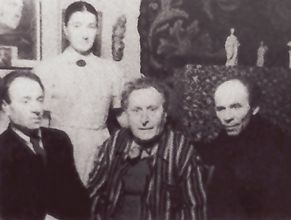
In 1964, a public discussion of Khrushchev's scandalous visit to the "30 Years of the Moscow Union of Artists", entailed repressive measures in the artistic environment, exhibition took place. At it, Irina Vilkovir used the podium to declare the seemingly seditious truth about the background of this conflict between the authorities and the intelligentsia. It referred to a carefully planned provocation by the then president of the Academy of Arts, Vladimir Serov, that was directed against young painters who developed a new trend or rather a movement - the austere style. Such actions during the peak of denunciation madness demanded real courage from people. After all, artists risked losing everything - their livelihood as well as their freedom. So why did the works of these authors, not related by family ties, become the basis for a small private collection? Irina Vilkovir knew Luba's parents, and once brought her to the studio of one of Moscow’s oldest artists and the last living member of the bodacious group of artists of the early twentieth century - "Jack of Diamonds". It was the workshop of Moses Feigin. This meeting was the beginning of her long-term friendship with the master and introduction to his incredibly rich inner world, that was closed from many.
The legacy of Moses Feigin is truly enormous, since very few people manage to live a whole century, not to say maintaining an amazing capacity for work and a desire to create all the way through it. During his long life, the master has created numerous works. He spent his young and more mature years creating works of the political portrait genre - he painted Lenin, Stalin and other party and government leaders, following the rules established by state officials and trying not to stand out from the general mass of Soviet artists. Finally, having been given his own workshop/studio at the age of 60, he found a new key to his creations. The artist was no longer young, with decades behind him when suddenly there was a place where he could do what he loved without being distracted by the everyday aspects of life, completely devoting himself to art, and making his dreams and fantasies come true.
In his new works, Moses Feigin seemed to have found a second wind, as he began experimenting with techniques and materials, introducing pieces of fabric, ropes, and foil into his works. He discovered the gift of an expressionist in himself. And he was not afraid to create abstract art at the time when even the word itself was a blasphemy. However, the master kept to his usual lifestyle - he did not take part in the heated discussions of the 1960-1970s, nor did he attend public disputes, display his work at apartment exhibitions, invite foreign diplomats to his place, or picket exhibition halls. Maybe that was because he was older than most of the artists of the Moscow underground, viewing their attempts to get out into the world art arena as childish pranks, or maybe he just got used to solitary work. It is possible that, having survived a terrible period of Stalin’s repressions, he was forever poisoned by a bitter pill of fear for his loved ones, as he knew too well how easily destinies can be destroyed because of the unintelligible slander of envious people. But it is most likely because the artist simply did not consider it necessary to waste hours of time on long meetings and talks about art, but preferred to simply create it. In this sense, the collection of Luba Matusovsky is unique, since its owner is one of the few people to have been friends with Moses Feigin, and he was confident that his works would fall into trustworthy and caring hands, and would not sink into obscurity. It is always important for an artist to know where and how his heritage will be kept. Thus, for example, the mysterious Pavel Filonov, who survived the lean years on hot water and black bread, did not sell a single painting in his life, but bequeathed all of them to the Russian Museum. And just like Filonov once, Moses Feigin was no less worried about the events taking place in the world. In abstract work.
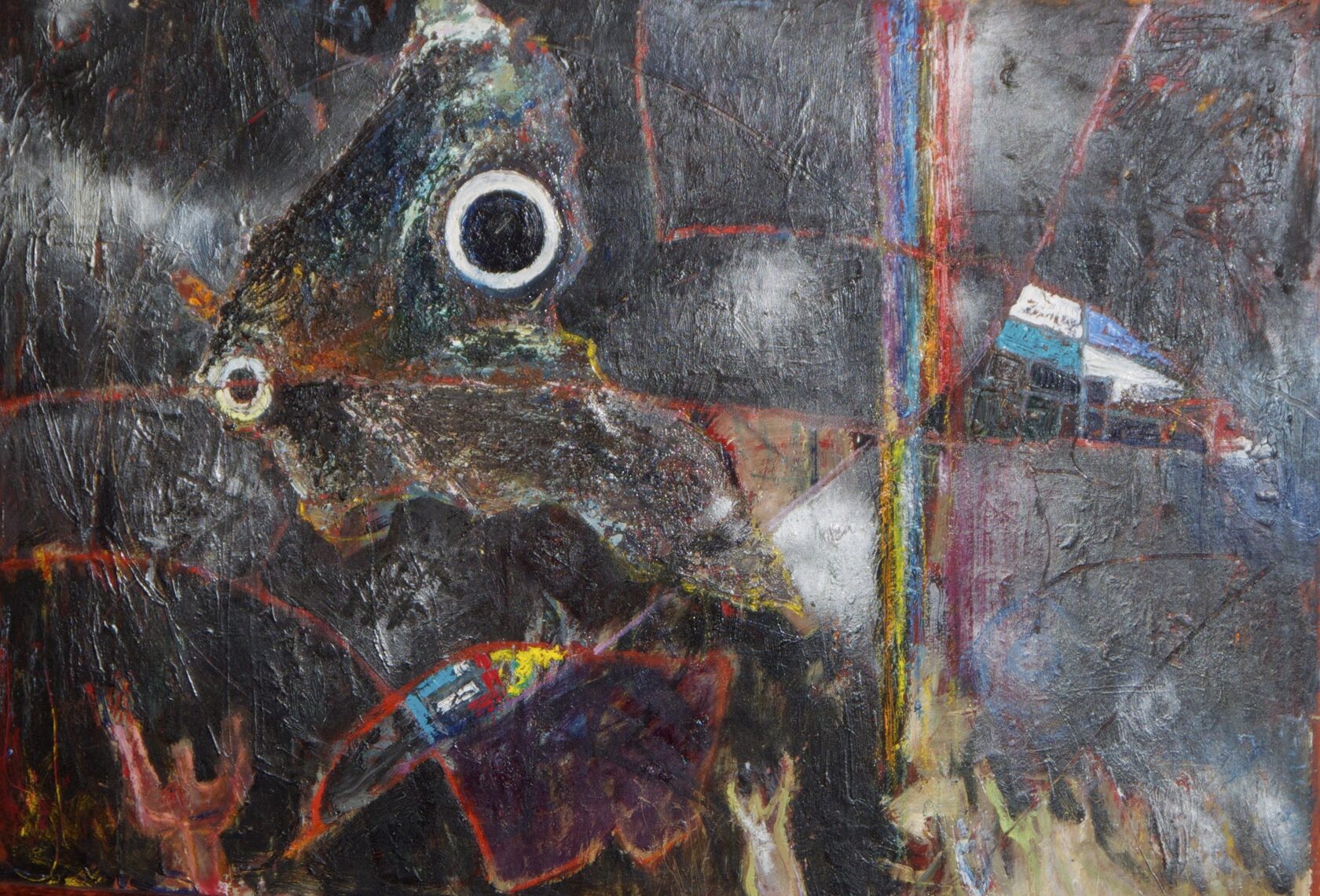
Feigin foreshadowed the coming cataclysms of the late XX - early XXI centuries, among which were the accident at the Chernobyl nuclear power plant (1986), the destruction of the Twin Towers in New York (2000), the flooding of New Orleans (2005), the earthquake in Haiti (2010) and numerous others. Red jagged lines cut through the black rectangle of the canvas. They glow against a dark background, like tracer bullets or sparks blazing from a fire. The center of the painting has a rough surface as if the paint had shrunk from high temperature. Two white rings of different sizes stand out in this area. Traditionally the ring, i.e. a circle served as a symbol of immortality, infinity, eternity, since it has no beginning or end. The "splashes" of red and yellow paint In the lower part of the painting resemble flame shapes.
A feature of the collection we are considering were the works of Moses Fagin in 1970-1971, in which he used gold and silver foil. Few of these works have been created - and many of them are collected from Love. Foil is a unique material that has the effect of shape memory, ie. it can change its shape depending on the ambient temperature. The image in the picture will be transformed depending on the heating of the foil (or its parts), and on the same plane the viewer will see first one image, and after a while - another, slightly adjusted. And the image can change gradually. And then a dynamic picture will appear before the viewer.
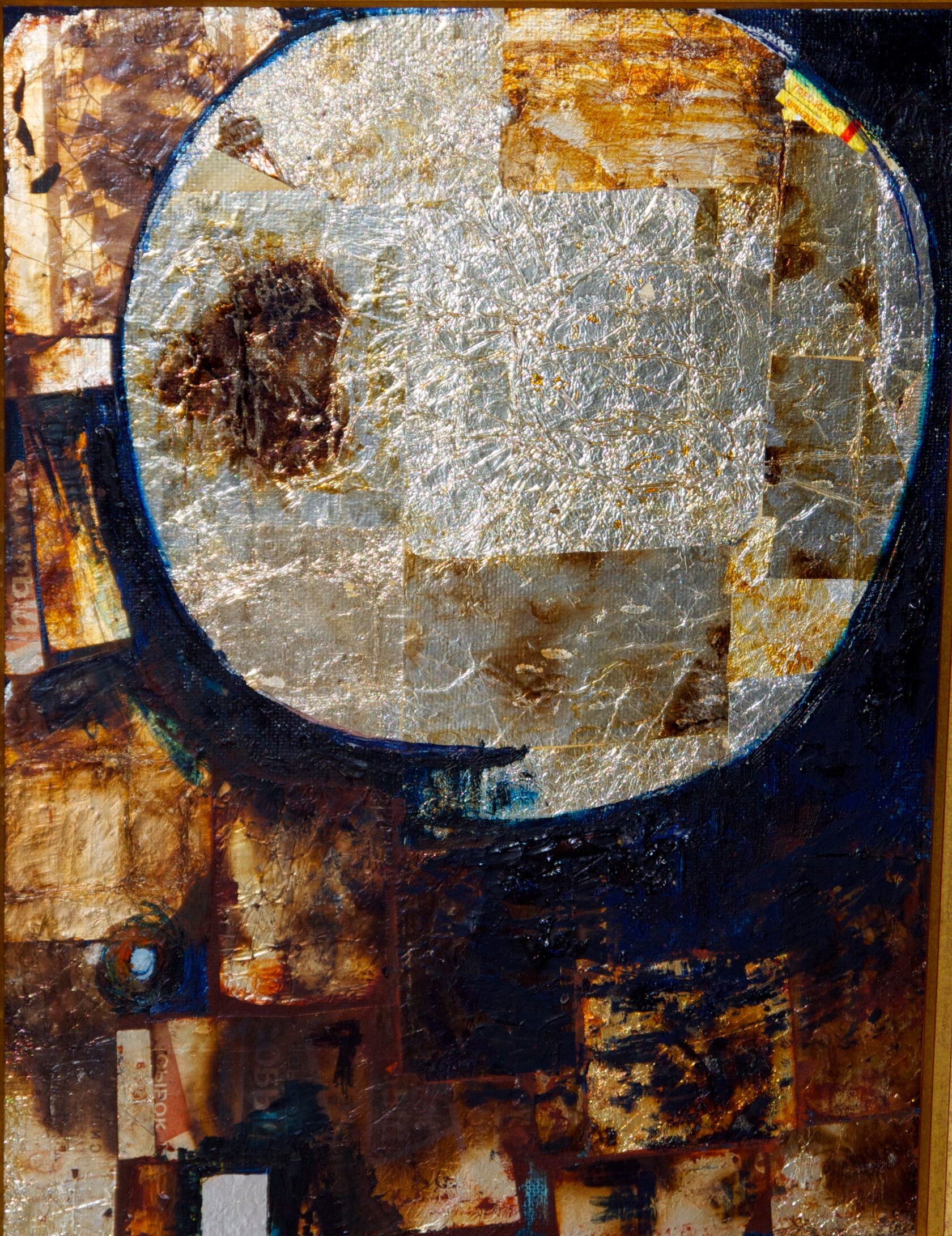
Thus, for example, in the work "Jupiter" (1971, 51x38cm, cardboard, oil, foil) bright sunlight is not only reflected from the surface of the foil, thereby highlighting an important detail of the composition, but the form also transforms under the influence of temperature, making the image alive and mobile, as if the current of time is transmitted in the picture.
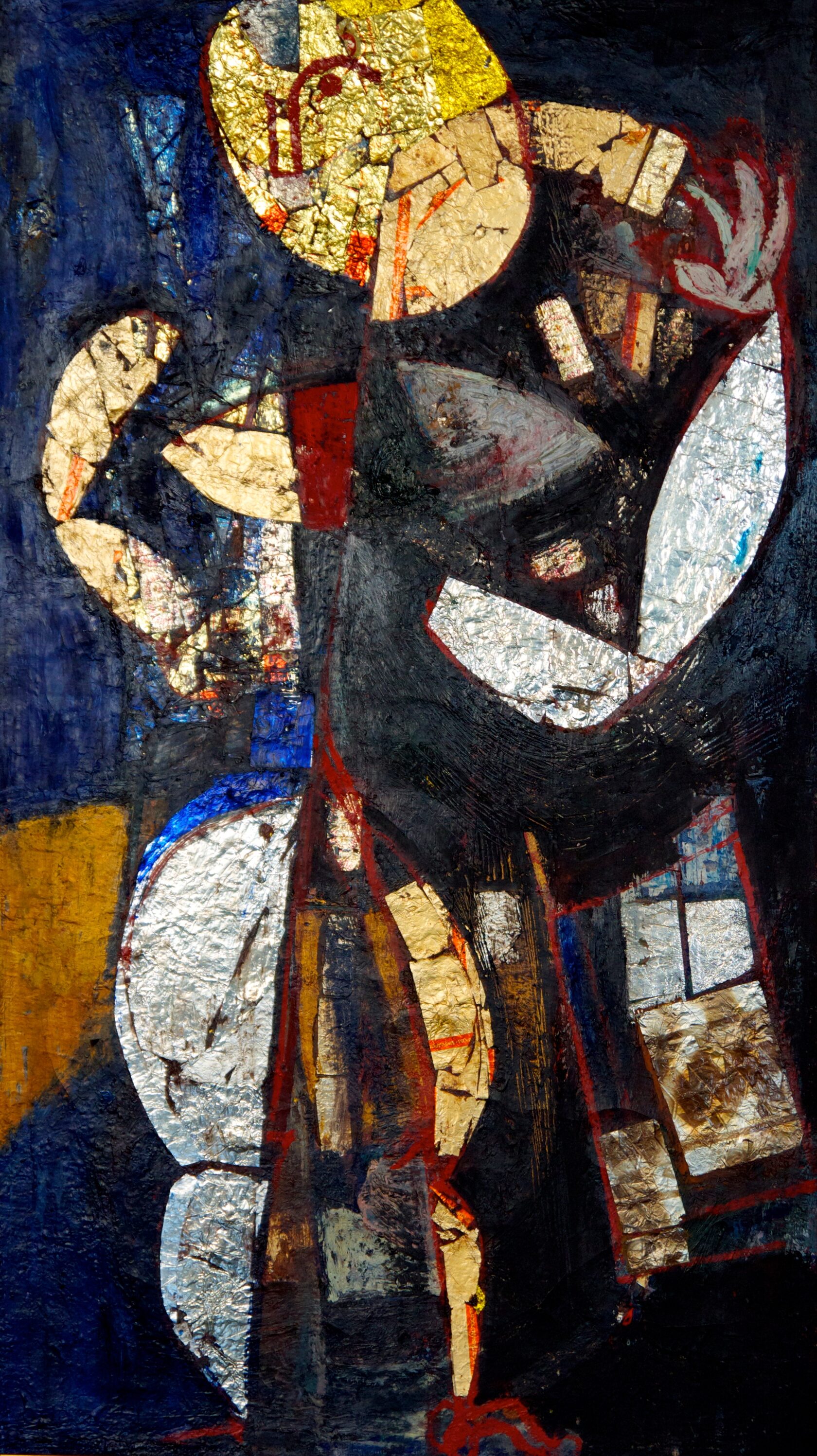
In "Beauty" (1970, 65x64cm, oil on canvas, foil) we first see only chaotically scattered shiny circles and ellipses against a dark blue background, reminiscent of the color of the August night sky. But they gradually take shape of a flirtatious feminine image - one hand of the lady is placed at the waist, while the other is raised, as if to tidy her hair.
The glittering of foil in religious themes gives Feigin's paintings a sacred meaning, the same as the golden assists do on icons, symbolizing the presence of Divine light.

“Temptation of St. Anthony” (1971, 76 x 83 cm, foil and oil on cardboard) is a profound work on this subject. The author himself considered this work to be one of his best and at first he had no plans to part with it. Lyuba Matusovsky’s intuition guided her to acquire the painting, prompting her that it was a real masterpiece.
The plot of the painting is an attempt by the devil disguised as a naked woman to seduce the holy elder. Saint Anthony is a Christian ascetic, considered the founder of hermitage. He was the first to live completely alone in the Egyptian desert, leaving people and fighting the temptations of the world and the flesh with the help of prayer. This rare piety attracted Satan's particular attention to him. At first, ordinary demons made several attempts to shake the saint's resolve with violence, and when this failed, their master took over. Appearing to Antony in the form of a beautiful queen and successfully demonstrating a series of good deeds, the devil tried carnal seduction of the elder. An experienced hermit immediately realized who he was facing and calling on all his piety for help, he managed to overcome the temptation.
For centuries, Saint Anthony was considered an instructive example of how to resist earthly temptations, to be on guard all the time, not to take everything to be the truth, no matter how much it seems to be, and to know that seduction can lead to being cursed by God.
St. Anthony was most commonly depicted being tormented by demons. These are the versions of the Renaissance masters of the XV-XVI centuries - Jacopo Tintoretto, Paolo Veronese, Martin Schongauer Albrecht Dürer, Jerome Bosch, Matthias Grunewald, Lucas Cranach, Peter Brueghel the Younger and the famous engraver of the XVII century Jacques Callo. Artists were attracted by the opportunity to demonstrate the richness of their imagination and show the terrible monsters that inhabit hell.
The seduction of the pious old man by a beautiful woman is not a rare theme, and the altar triptych by Hieronymus Bosch (1505-1506) is a well-known example. Kept in Lisbon, it portrays the saint staring eerily to the side and the she-devil. The naked woman, appearing behind a curtain which has been pulled back by a toad, turns out to be a demon disguised as a princess. A dry tree trunk, behind which she hides, is an alchemist symbol of death. St. Anthony looks to the side, but can still see the feast demons beckoning him. In the background we see the she-devil’s beautiful city that is ready to welcome the hermit, should he just turn his head towards her.
St. Anthony’s image remained the central focus of the exploration of temptation, and Surrealists Max Ernst and Salvador Dali as well as many others continued to incorporate him into their works of the 20th century. “…Demons are not visible bodies, but we can be bodies for them,” wrote St. Anthony. In Paul Cezanne’s painting (1873-1877), the demon is represented by the image of a beautiful bathing woman and the horned figure of Satan hangs over the saint who is resisting temptation. In 1946, Salvador Dali set the subject of his painting in the desert with a fantastic cavalcade of long, thin-legged, elephant-like creatures led by a white horse carrying a naked princess on its back and the entire scene looks like an approaching mirage to the saint hiding behind the cross he is holding in front of his face.
In his painting on the same subject, Feigin gives the main focus to a female body in an open scarlet dress with her head thrown back and her breasts bare. There are two depictions of St. Anthony; his body is rendered with bent head and a big pink foot, and a pious soul shines blue above him reflecting the highly spiritual nature of the figure. The woman’s nude body is painted with gold foil to emphasize how the subject of seduction blinds the old man.
In Christian teaching, seduction is a sin. However, sin is also used by God to test the man’s faith through suffering or examination, in which God reviews the man to know his heart.
The subject of seduction was very important not only for painters but also for many writers such as Gustav Flaubert who created a philosophical drama which narrates the trying experiences of Saint Anthony. The saint appears in the drama as the symbolic image of the creator as he is plunged into the creative process. Feigin probably knew Flaubert’s story and expressed the same thoughts in his own work. The painter likely considered giving up his artistic work and creating works for the collective public good. Ultimately Feigin chose a life of solitude without participating in his own community. He did not attempt to relate his aesthetic with his contemporaries. In this sense one can link Moses Feigin to the main protagonist of Flaubert’s novel.
Despite plenty of religious subjects in his work, Feigin was an atheist. In his late interviews he stated that the older he grew (he was 104 when he died) the more certain he became of the idea that “there is nothing more beyond this life.” With the help of Christian subjects, Feigin tried to answer eternal questions about the origin of the universe with his work, such as “Where are we from? Who are we? Why did we come here? What is the sense of being?”. Within his works there are several variations of “Calgary”.
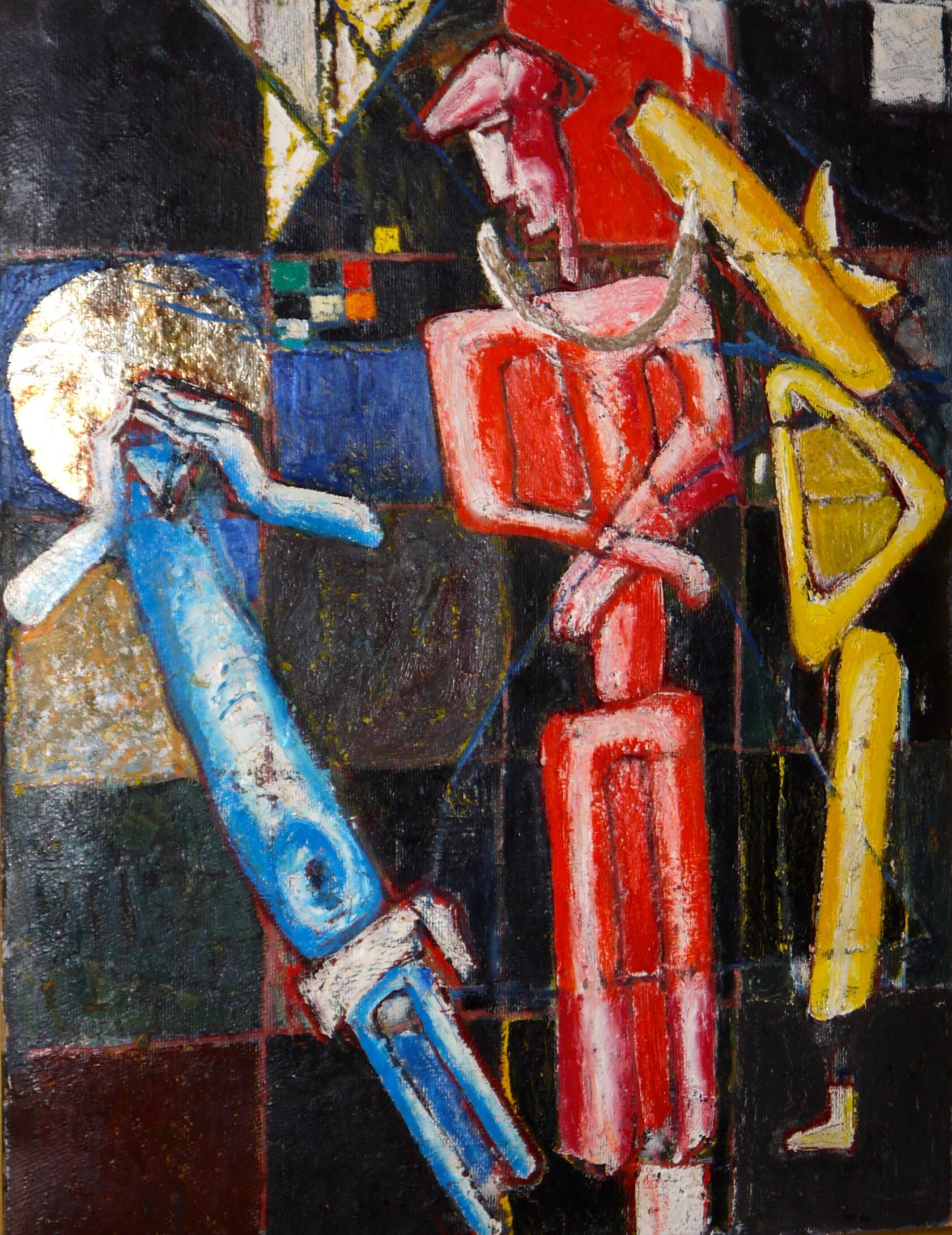
On the painting “In the Torture Chamber” from the series “Damnation of the War” and “You Will be Hung” (1975, 100 x 80 cm, oil, foil, cardboard), there are three bodies in the background of masonry. Each is a distinct color. The figures of carmine-red judge and yellow counselor condemn the convict, the man sentenced to die, who is holding his head painted in rich blue. The painter metaphorically reminds us of the history of Christ. The nimbus around his head is made with foil. It is as shiny as the Byzantine mosaic in Cecilia. Not knowing the name of the work one might suppose that it was inspired by the Bible, but the painter refers to World War II. There is another interpretation of the painting: The yellow figure is an executioner with the hood, the red is the hung man with folded arms on his chest and a noose around his neck, and the blue one is the Christ covering his head with his hands in horror, unable to watch the manslaughter.
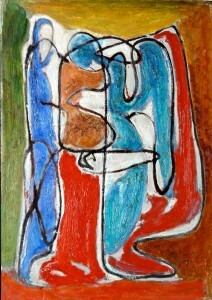
The painting ”Confession” (1970, 65×64,5 cm, cardboard.) is devoted to one of the most secret religious rites, the confession of sins. The two bright blue spots designate the bodies of people are mingling on the white background. The white color is the divine, a symbol of light, purity and truth, and the color of purification from sins. Blue in the Christian tradition is the color of chastity and justice. The drawn black line coincides with the contour of the human figures. They form an ornate pattern, where black is the symbol of repentance and sin. The figures oppose each other: the left figure is straight like a pole, the right one is sitting in the blue armchair like an angel with the folded wings behind its back. There is a red orange framing between them.
The background around the perimeter is of different colors. At the top, it is yellow, which is a symbol of divine power. In addition, yellow is the color of betrayal, jealousy, cowardice, and lies. In some European countries, the doors of the houses of criminals and traitors were smeared with yellow. Judas and Cain are usually depicted with yellow beards. The background at the bottom is orange, which is sometimes considered a symbol of infidelity and voluptuousness, but it can also be regarded as a hint of creative activity, since the muses as daughters of heaven and earth, wear orange outfits. On the right it is red, which is associated with blood, fire and anger. But it is also the color of life, strength and courage. The left part of the perimeter is green - the color of spring, growth, joy, hope. This color often symbolizes continuity and immortality, as well as indicates the connection between the natural and the supernatural. There are numerous mysteries in this work, and the abstract solution of the painting multiplies them and does not give a specific answer to the questions that arise. Only the hidden symbolism of laconic colors allows you to read the encrypted message of the author.
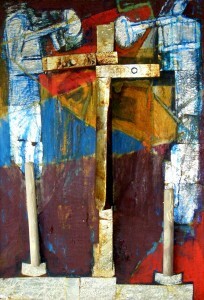
In “Traffic Light of Life” (1971, 70 x 49 cm, wood, foil), a strip of foil divides the painting vertically into two parts, making it resemble a road sign. As it was in a Russian fairy tale: Go left and lose your horse, go tight - lose your life, go straight - find happiness. Thus it is in life - each person has to make choices hourly, for a variety of trivial reasons. At the same time, this sign resembles the shape of a cross - a symbol of the logical conclusion of life for a Christian. On the right and left, there are figures of people that are barely drawn. One of them is straight, as if holding a calling horn, and the other is with a low bowed head, as if submitting to the choice from above. When you look at this work, an allusion to Viktor Vasnetsov's painting "The Knight at the Crossroads" involuntarily comes to mind. Philosophical themes are woven into many other works of Moses Feigin.
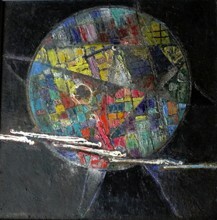
The central part of the composition is occupied by a multi-colored ball, reminiscent of the view of our planet from space. The lower part of the painting depicts three long whitewash strokes that can be interpreted to be comets with long tails sweeping past or human souls flying away. The works we have considered, despite the very specific names and easily guessed figurative images, should nevertheless be attributed to the abstract direction in art. However, Feigin was not a clear follower of anyone, even Kazimir Malevich, whom he considered a genius. Feigin’s work, balancing between the objectivity of being and the abstraction of associations, can be characterized as a pictorial-geometric abstraction.
In late 1980’s, the painter worked on an extensive series of paintings. He painted clowns and barnstormers, including the beloved Charlie Chaplin. Feigin created unforgettable portrayals of this small man in the black bowler hat in both funny and sad situations just as Chaplin appeared in his movies.
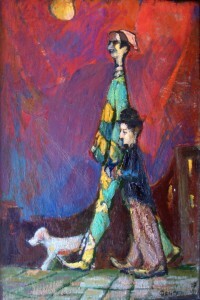
In the painting “Trio” (1987, 64 x 45 cm, oil, fiberboard) we see a tall harlequin and Charlie standing next to him against the backdrop of the blazing crimson sunset. The actors look directly ahead, as if in a hurry to get to their next performance.
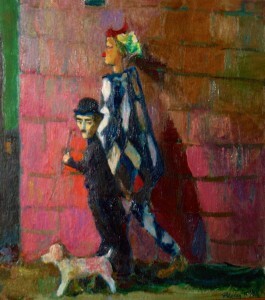
In another work also named “Trio” (1988, 49 x 45 cm, cardboard), these characters move along a red brick wall suggesting the beginning of the 20th century when huge industrial blocks were erected in cities. We do not know where they are going, though the fate of street jesters is usually the same. They themselves do not know where they will find themselves the next morning and if they will have enough money for food. Such peculiarity distinguishes many creative people, including painters. Their work often depends on successful sales. A sad look that Charlie Chaplin is directing straight at the spectator confirms this thought. What is ahead for this strange trio in the future? Perhaps obscurity, but the important thing is for them to keep moving forward.
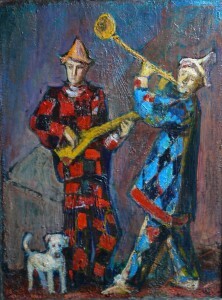
In this series, Feigin painted a couple of “Scomorochs” (“Clowns”) (1986, 65 x 50, cm, cardboard) - Russian buffoons and jesters that are dressed in bright costumes holding the Russian folk instruments - balalaika and zhaleyka - in their hands. The faces of the musicians are sad and their song is not merry. A little white dog hides between their legs. Looking at this work, one remembers a painting from the Russian Museum that is a self-portrait of two painters who were friends - classicists of the first half of the 20th century, Vasiliy Shukhaev and Alexander Yakovlev, depicted as Harlequin and Pierrot.
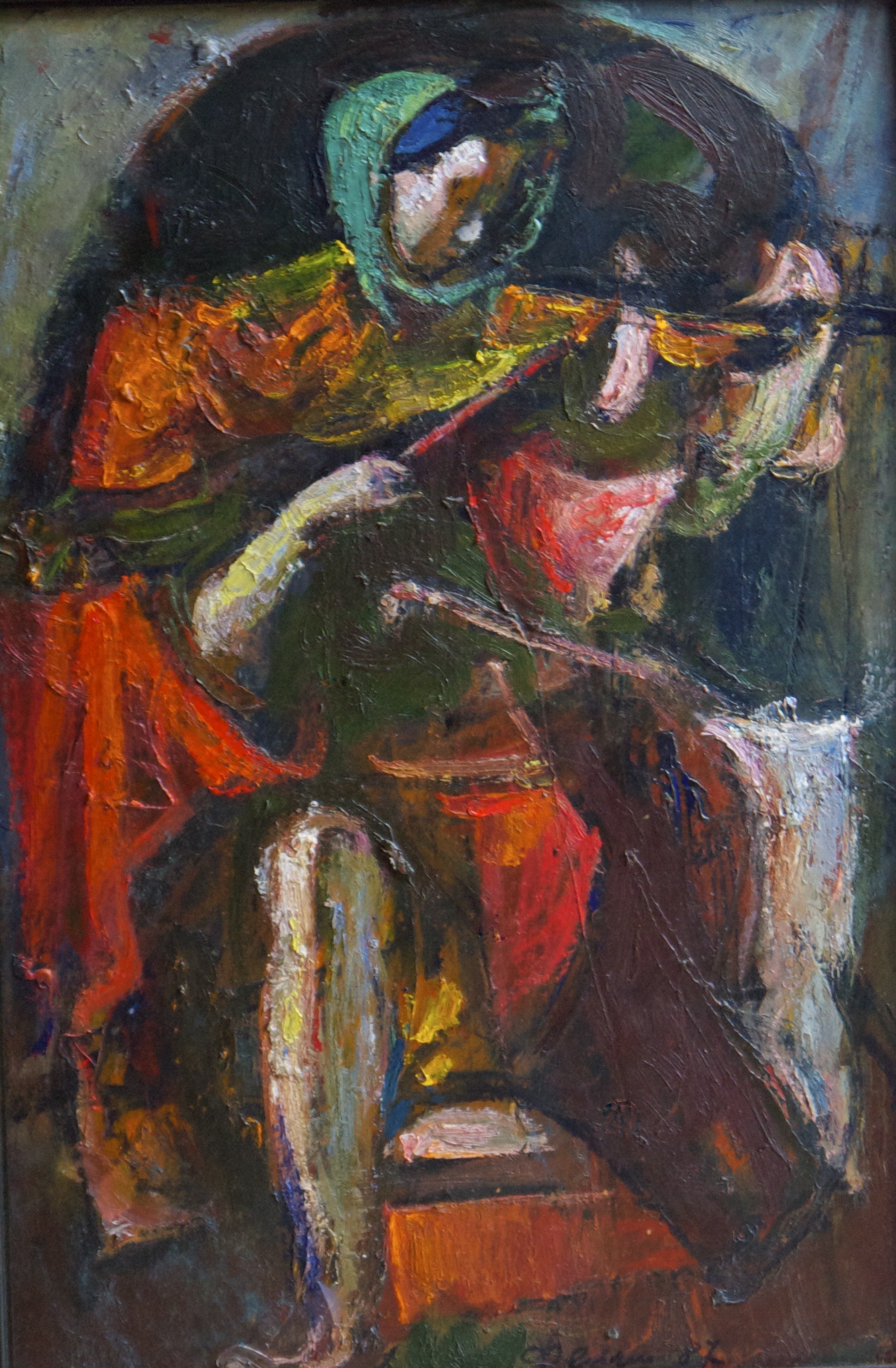
The musician theme continues with the work “Concert” (1987, 48 x 31 cm, oil on cardboard). This little work on board carries monumental features reminiscent of the Michelangelo’s frescoes in the Sistine Chapel. The figure of the violinist is in the center of the architectural bay. The emerald kerchief on her head and big pleats of the red dress create unusual and beautiful combinations of colors on the painting. It almost literally makes a “sound.” A complicated turn of the body and the arrangement of the figure are reminiscent of the Michelangelo’s image of the ancient seers who foretold disasters.
The picturesque world of clowns and actors glorified by Feigin comes from the famous line from the Shakespeare’s play “As You Like It” - “all the world’s a stage, and all men and women merely players”. A modern society is a masquerade where people prefer to hide themselves under different masks, where sincerity is valued less and less. The painter felt this trend and implemented it in his works. In the words of Italian contemporary art critic, Akile Bonito Oliva, “Moses Feigin had the strength to come away from all the anchors, leaving his thoughts about priority direction of movement, and propel without helm and sails, not correlating with the center and even as far as the periphery and roadside”.
Feigin’s artworks contain ample amounts of search and exploration. Shortly before his death in 2008 he was included in the Guinness Book of World Records as the oldest professional working artist in the world. Independent experts have also finally recognized his talent.
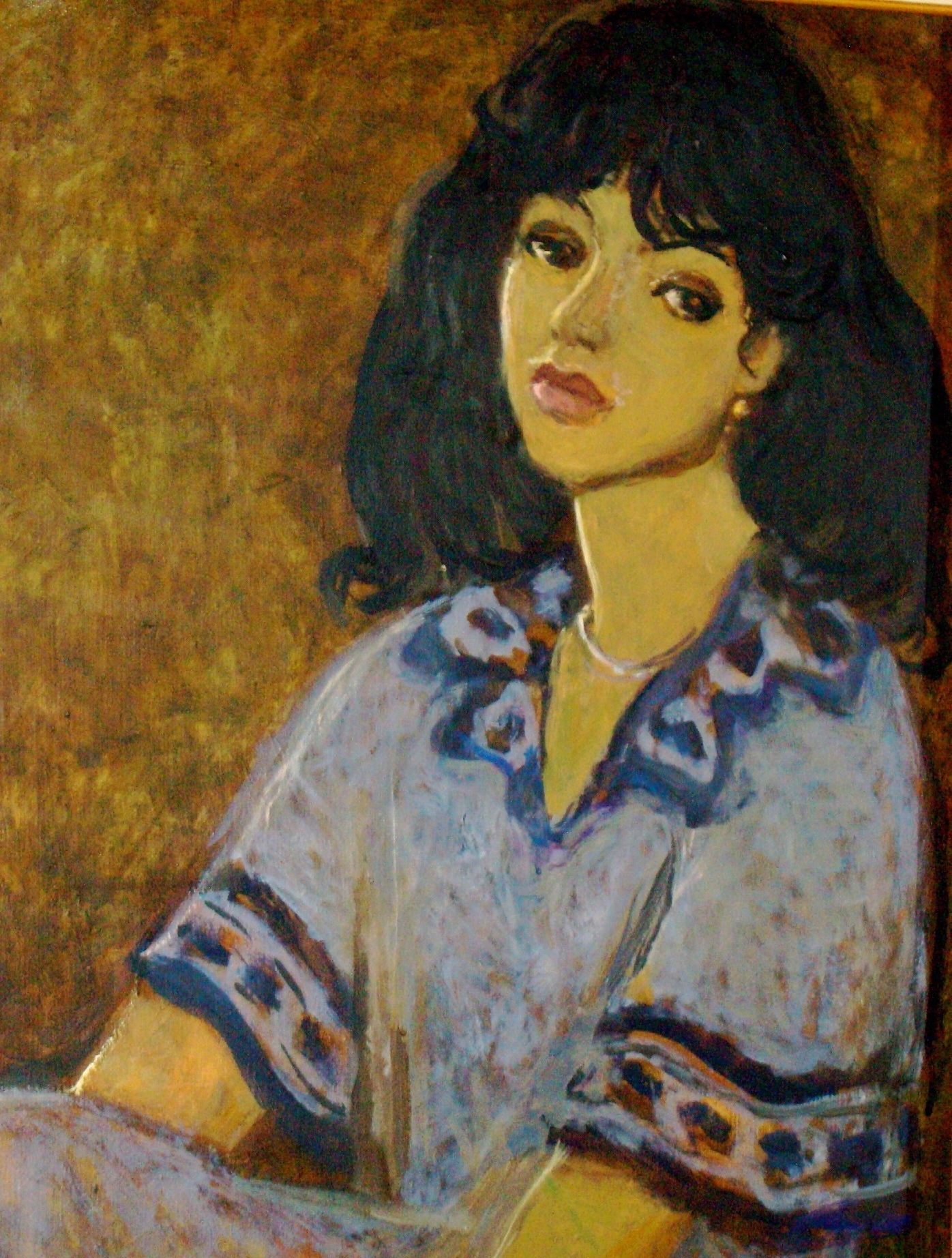
Matusovsky’s collection also includes works of Irina Vilkovir. They characterize the painter as an excellent colorist, and a master of innovative forms.
Vilkovir and Matusovsky began their friendship after the artist painted the portrait “Lubasha” (1979, 89 x 60 cm, can). The dark-haired girl in the white embroidered shirt looks at the spectator with her eyes half-closed. The secrets of the girl’s dreams are concealed. This work is reminiscent of “The Sunlit Girl” by Valentin Serov. Massive features and patterns on the garment are brought together with a Matisse-like contrast.

Her other portrait, titled “Luba” (1982, 66 x 45 cm, can.) transmits a very different state of the model. A bright red woman’s jacket and the outline of her hair, almost lost in the dark background, are in keeping with the works of the mysterious Frenchman George Rouault.
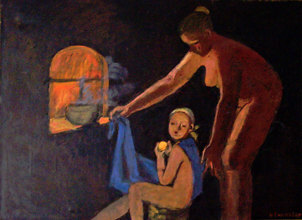
In her painting, “Banya (Russian Sauna)” (1978, 118 x 88 cm can.), naked bodies of a woman and a girl are brightly lit in a warm orange light coming from the stove. The use of few colors and the angularity of the forms echo the rigid style of Soviet painters Andrei Vacnetsov, Viktor Ivanov, and Igor Obrosov.
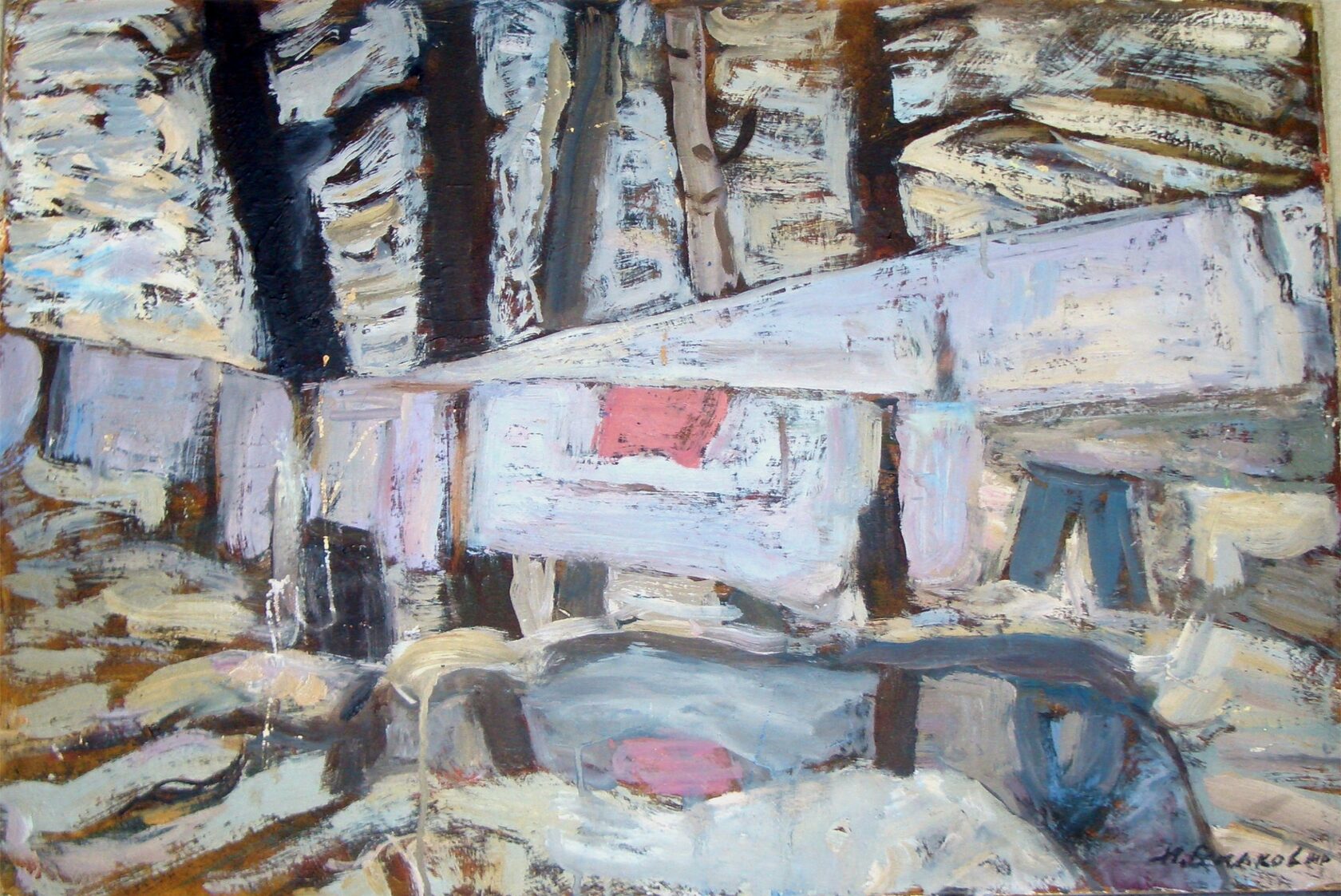
The work “The Linen” (1971, 63 x 50 cm, org.) is painted with big expressive brush strokes. It looks as if it is made not with a brush but with fingers. The white sheets give the sensation of coolness of frosty morning and the crackle of cloth is covered with ice against the background of snow-covered trees.
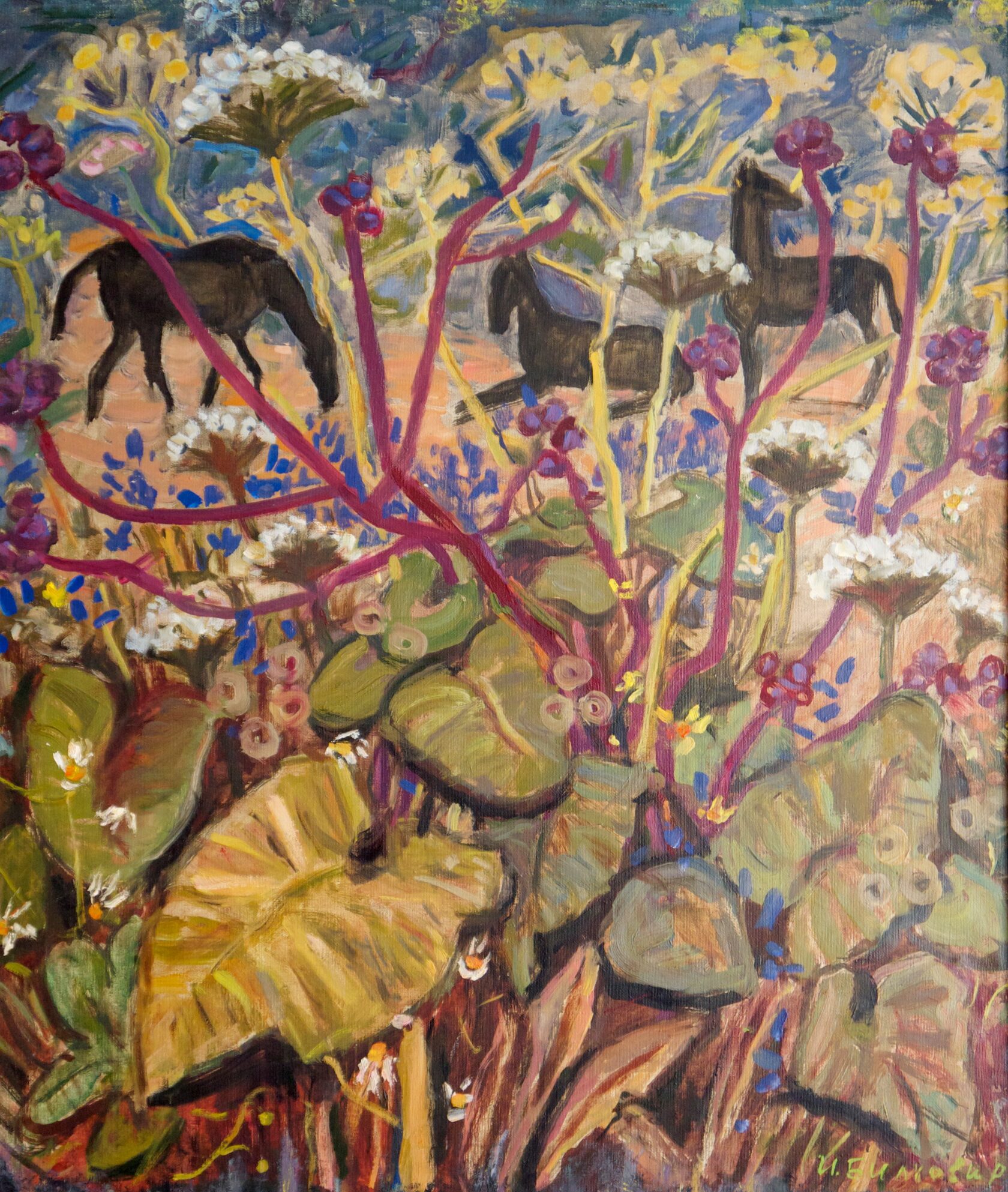
In “Autumn” (1978, 98 x 88 cm, can), we see grazing horses through the big green leaves. The painting is very decorative with color combinations such as lilac, bright blue and marsh. It is perceived almost like an illustration for a book.
The name Vilkovir has been undeservedly forgotten, but her art makes for remarkable displays of her rare gift of incarnating nature while simultaneously picturing the mood of a model and her own momentary impression. Such lightness of vision was characteristic of impressionists.
The painter’s love for wide and bold brush strokes, contrasting colors and the convention of forms reveal her devotion to expressionism. Boldness and inner freedom were not typical in Soviet art. She developed these talents in Vkhutemas and MAU, known for their informal traditions.
Both Moses Feigin and Irina Vilkovir acted as bold reformers through their creative work. It was important to them not to imitate or represent reality. They did not set themselves the task of reflecting it. On the contrary, both artists tried to change it according to their inner comprehension.
A modern artist is attentive to the details and gains pleasure from an integral vision of all things lost. Eclecticism helps to neutralize differences, closing the gap between different styles and erasing the distance between past and present.
The process of nurturing an art collection is a delicate work, and is often done subconsciously. The works in the Matusovsky collection are a reflection of her personal world and character. It is something transcendental, beyond logic, where beauty is left undefined, but not undeniable.
The collection of Lyuba Matusovsky is like a necklace. It consists of genuine pearls - first-class works of talented authors that complement and adorn each other.

